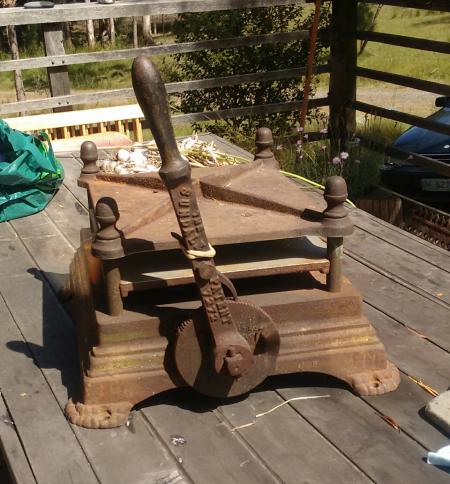Sundale patent 7272
GDay Briar Press members…I was down in Huonville in Southern Tasmania recently and came across this little press…I assume it is a proofing press…or maybe made specifically for bookbinding. I have not been able to locate information or other examples in what has been a fairly shallow search online. The lever operates two cam lobes in the base…pull down and the bed rises and is held in place by the pawl…the spring has gone…the rubber band suffices for the moment. …I would welcome any information. This is a great site and I am pleased to be a new member.

Sundale press.jpg
Perhaps tangentially related:
http://www.lathes.co.uk/seligsonnenthal/page3.html
It’s a UK patent number. Sonnenthal, G. and Martin, W.
May 31 1886
Copying Press
https://books.google.ca/books?id=QiaTD4uDz2AC&lpg=PA268&ots=6ds4h_LExH&dq=patent%207272%20book%20press%20-Essential&pg=RA1-PA122#v=onepage&q=patent%207272%20book%20press%20-Essential&f=false
Thanks to the disorganization of the UK/EU patent system, I’m not able to find the original patent document anywhere.
copypress.png
Just noticed: the lathe was a Selig Sonnenthal lathe, and Sonnenthal is one of the names on the copy press patent. Seems Sonnenthal had a thing for Sundale.
I suppose it’s not a leap to assume Sundale was an anglicization of Sonnenthal.
Google Translate says Sonnenthal is “sunny valley”, so Sundale is right on.
It looks to me to be a variation of the copying press - the kind that usually has a wheel on top to lower the platen. These are used today by bookbinders, but originally they were intended for making copies of letters, receipts, etc. written on copying ink.
thank you Keelan, AdLibPress and Stephen O Saxe for the information about the Sundale copy press. Summing up, it was designed and manufactured by Selig Sonnethal, an engineering firm in London in the period (maybe)1880-1900, and this company also imported tools and engineering supplies from Germany and put their nameplate on them. If the machine was copied the trade name was placed in inverted commas. I wonder what the copyng process was…direct transfer would invert the image, and any process involving gelatine would not I think require a great deal of pressure.
Such cast iron copies were frequently made by disassembling the machine and using the cast iron parts as foundry mold-making patterns, molding in founders sand in the same way wooden patterns were used. The process involves about 3% shrinkage as the iron cools, so the copies are typically about that much smaller than the originals. Many hand presses were copied by competing manufacturers this way.
Bob
James Watt invented the letter copying process in the late 1700s.
http://mikerendell.com/james-watt-inventor-of-the-desk-top-copying-machi...
There were a number of patents for different type of presses. The most common was a screw press which turn up regularly on eBay advertised as bookbinder’s (nipping presses). The screw press would allow several letters to be copied at the same time. The copy press reduced the need for copy clerks in businesses. English presses are normally plain and some French ones are really beautiful items.
38945294374_42a38209e7_o.jpg
38902412154_6b03614c72_o.jpg
thank you Bob from AdLib press and Platen printer for your different takes on the practice of copying a press and the copy press. Both interesting….I was certainly not aware of James Watt’s innovation in the arts of copying letters and other documents.